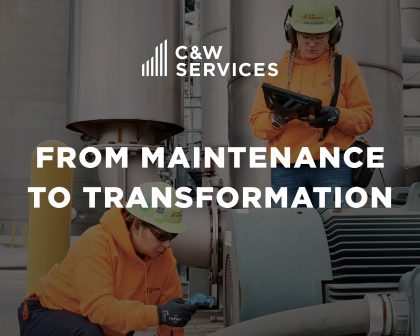If your team is considering changing the maintenance approach for HVAC equipment at your facility, the first strategy often implemented is a Preventive Maintenance (PM) program. Building a robust preventive maintenance program is an important initial step to building a reliable database to improve equipment uptime. As the facility maintenance program matures, it’s also important to consider future continuous improvement processes for equipment and assets.
It’s critical to recognize when implementing a Condition Based Monitoring (CBM) solution for HVAC; you must comprehend the value that predictive maintenance (PdM) brings in terms of labor efficiency and reduction in equipment downtime. Often, preventive maintenance tasks at facilities are being completed on the calendar year schedule based on recommendations from engineering best practices. An example of improving this would be to replace outside air filters in an HVAC unit semi-annually or replace supply fan belts yearly. Shifting from preventive maintenance to predictive maintenance requires a system that is easy to use and will automatically collect and analyze asset condition data. When C&W Services completes an assessment of the client’s site for a monitoring solution on their rotating and non-rotating equipment, we will consider multiple holistic options and select the best solutions for the equipment based on the following criteria:
- A system that provides a machine learning function (AI component)
- Real-time notification of developing problems
- Detailed analyst features for alarm investigated
- Ease to install the operating solution
- Strong return on investment
- Energy reduction potential
Before the predictive maintenance program is implemented, the critical assets should be identified. It’s important to work with the site to develop a criticality ranking to insure the most critical assets are in the front of the implementation process. Often when you think of predictive maintenance as the application for detection of increased vibration, there are missed opportunities when you only apply one predictive maintenance technology to an asset. When identifying a solution for critical assets there are many key areas and value drivers that should be contemplated to offer the client the best solution. A few examples include:
- Improved mechanic wrench time
- Increase equipment reliability
- Reduced unplanned downtime
- Reduction of preventive maintenance (PM) intervals
To identify the ROI of a CBM investment, there are a few considerations to think about for each sensor. At C&W services, we work with our clients to identify all potential savings and we look at each sensor to determine its value. There are a few key elements to consider:
- A vibration sensor will detect misalignment, imbalance, looseness and bearing wear. This will reduce belt replacement, sheave replacement, and lubrication intervals.
- Temperature sensors can detect heated sections of an electrical panel to draw attention to an electrical concern prior to failure.
- The temperature sensor will also detect late stage bearing issues, which will allow you to plan down time verses a catastrophic failure.
- Current draw for electrical motors can assist in identifying high energy users.
In HVAC systems, we often find that filters are replaced before being fully loaded or after failure. Consider Deferential Pressure for example, which is measured across the filters, and will identify when to replace the filters per the manufacturer’s recommendations. This will reduce filter replacements.
A big energy user at manufacturing plants is steam trap failures which will over pressurize a condensate system and not allow condensate to return back to the boiler. Ultrasonic sensors can detect high-frequency emissions generated from the mechanical and fluid flows of traps. This will assist us in identifying a failure in critical systems and plan a replacement before it has impacted the site energy consumption.
It is necessary to complete a Wireless Network Assessment prior to CBM being implemented. This should be an onsite survey to have a better understanding on how the network communication signal is affected by real objects. The quality of the signal can be affected by the number of users, building layout and construction materials, including exterior wall materials. You must also have a complete understanding of the physical layout of the HVAC unit for monitoring locations and sensing criteria.
Below is an example of an HVAC unit monitoring locations (Source here):
The core of LEAN maintenance is to reduce waste from inefficiency in physical assets; such as over-processing and inventory materials. The LEAN maintenance philosophy can be driven by a strong predictive maintenance program in place, which allows for better planning and scheduling, more efficient spare parts management and optimal allocation of resources. CBM is a maintenance strategy that allows us to monitor the actual condition of an asset; extracting information to understand the machines degradation and if a change has occurred. Results include minimization of parts and labor consumption, as well as reduced interruptions to operations.
At C&W Services, our dedicated team members lead maintenance transformation across multiple companies and industries. Our company believes in a proactive maintenance philosophy that provides our clients with options to implement new CBM processes and innovative technologies. We bring CBM technologies together across multiple industries, including pharmaceuticals, manufacturing, and production facilities nationwide.
For more information or questions, contact Gary Stevens at gary.stevens@cwservices.com.





